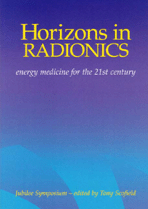HORIZONS IN RADIONICS
A new book published to celebrate the Diamond Jubilee of the Radionic Association. Edited by Dr Tony Scofield
250 pages. ISBN 0 9545786 0 0. Published October 2003. £14.99

Horizons in Radionics is the first book for many years to explore in depth some of the aspects of this practice and to bring to the reader, whether they be experienced practitioner or interested layperson, a greater understanding of the philosophy and practice of this powerful technique.
In the first chapter Linda Fellows explores the relationship between radionics and modern science and provides a convincing argument that aspects of radionics have parallels with modern concepts in quantum science. Tony Scofield describes the early history of radionics and its trials and tribulations. Working largely from primary sources this well referenced chapter provides some interesting novel insights into the early evolution of the therapy. Gillian Lowe discusses the radionic approach to treating chronic disease while Alan Gwilt does the same for terminal illness. Alan also describes treatments for patients after they have died which ease their passage. Both chapters are illustrated with case histories.
In an authoritative essay Nick Franks, a homeopath as well as a radionic practitioner, discusses the role of homeopathic miasms into radionic work. The concept of the chakras, introduced from Eastern mystical tradition, is discussed from a radionic standpoint by Cathy Marshall. Cathy extends the major chakras with some ‘minor’ ones which she has found valuable in radionic treatment. The area of ‘rates’, the numbers used on the radionic instrument for both analysing and treating, is discussed by Ina Manzoor, for many years the official rate maker for the Radionic Association. This is a valuable contribution in the light of ongoing discussions in this area.
The next chapters deal with analysis and treatment in specific areas. Three experienced practitioners, Sally Higham, Doris Frankish and Linda Fellows, describe some of their human case histories and other experiences in radionics. Galea Parsons, a practitioner with a large horse practice, describes horse case histories, but in her first chapter she deals with the subtle anatomy of the horse and how it relates to the physical anatomy. Subtle anatomy is the level at which the radionic practitioner works.
Radionics has been used extensively in the field of agriculture and horticulture, especially in the United States where treatment of humans has been forbidden. One of our most experienced agricultural radionic practitioners, Enid A. Eden describes the history and scope of this field and illustrates her chapter with several case histories.
Tony Scofield, in another heavily referenced chapter, has returned to primary sources to present his views on geopathic stress – what it is, how it is caused and how it is treated. He draws on years of experience in the field to present a comprehensive synthesis of views. Finally, Tony Scofield describes the major developments in Europe in radionics with particular emphasis on current practice involving computerised and digital instruments. Again well referenced this chapter provides a clear indication of where developments in radionics are currently leading.
There are 13 chapters, an Introduction to the book which includes a brief history of the Radionic Association and the book ends with a subject index.
Review
Exactly what I was looking for. (A.J.D. on Amazon)
Great, up-to-date contemporary book on radionics. What I like about the book is the different perspectives of the individual radionics practitioners who contributed. It provided material on lots of different questions that had formed in my mind when investigating radionics. There were also case histories which I found inspiring. I haven't, believe it or not, investigated Tansley's writings yet, even though these are the first port of call for many practitioners. I was inspired after reading it to train and to really dive in the area. As there is so much depth and so much scope in this healing modality. It is also fascinating.